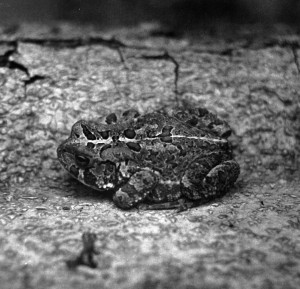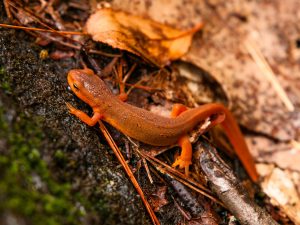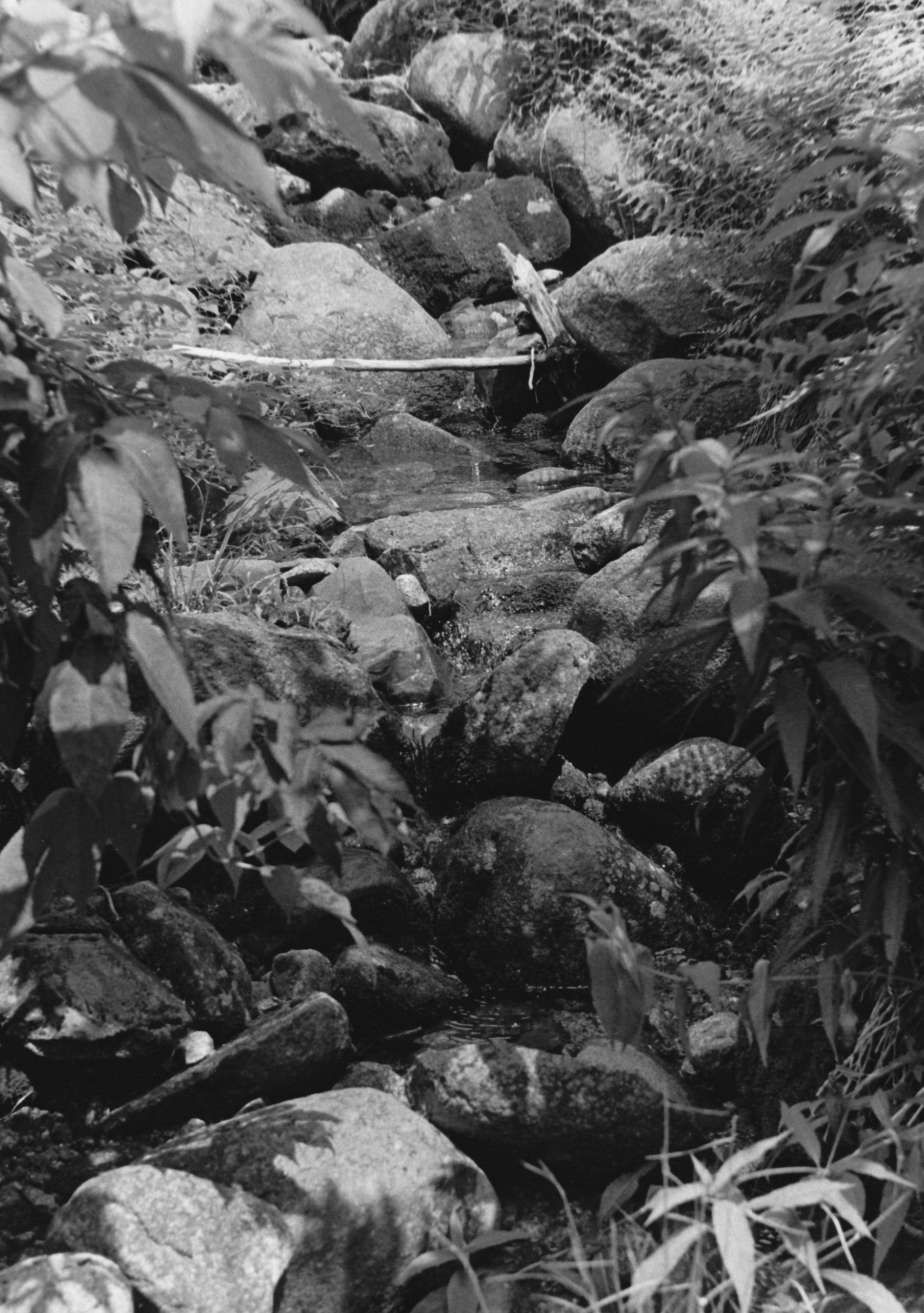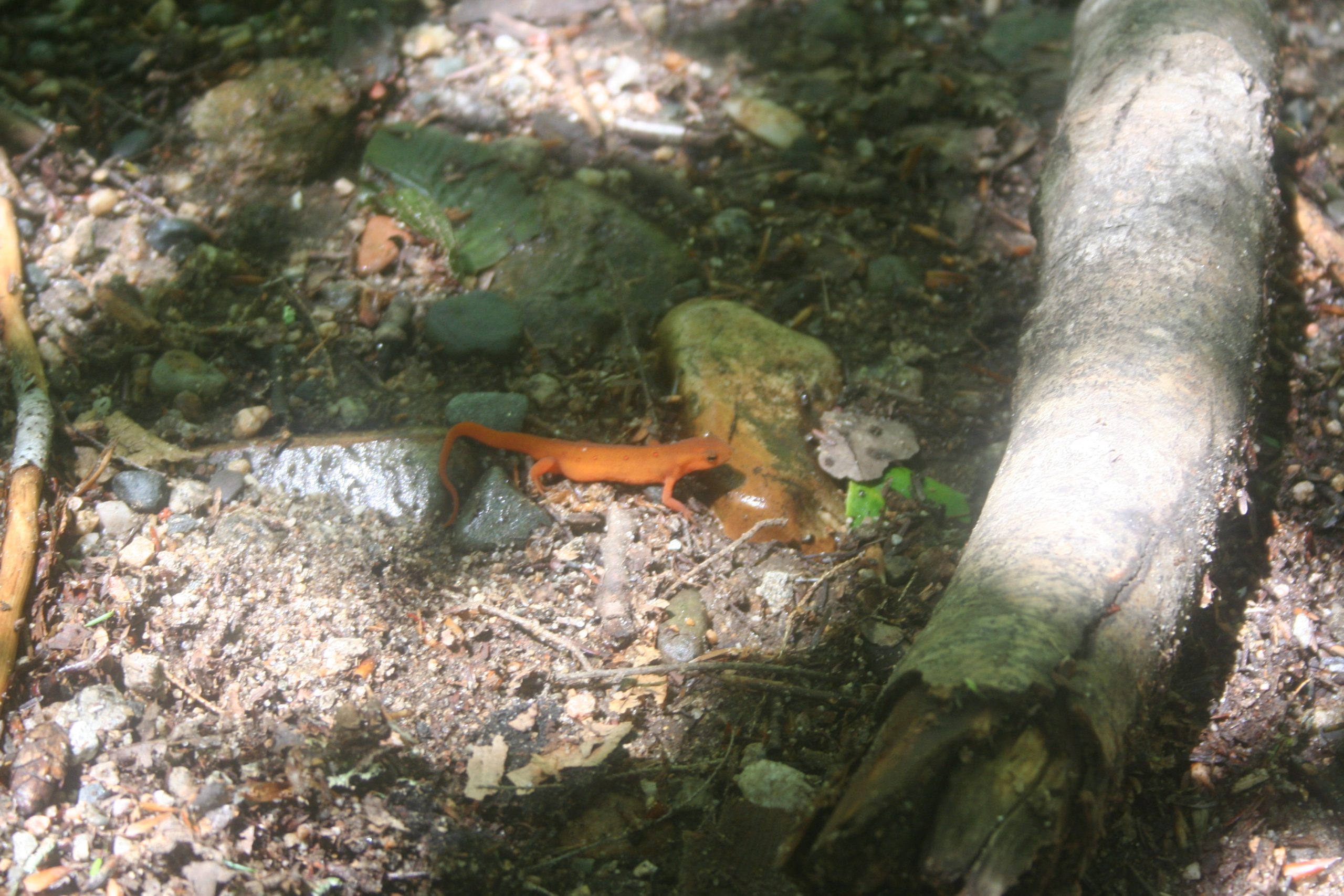
Frogs, toads, and salamanders are amphibians. Snakes, lizards, and turtles are reptiles. All are vertebrate or backboned animals and cold-blooded. They do not have a thermostat inside them, as do the warm-blooded mammals and birds. Internal temperatures of warm-blooded animals stay about the same. For humans the temperature is 98.6 degrees. Cold-blooded animals have a much wider range of body temperatures. If the air temperature is very warm, a salamander’s temperature rises to match the air temperature. If the air temperature gets very cool, the salamander’s temperature becomes low too. Low temperatures make salamanders sluggish. If the temperature gets too cold or freezing, the salamander will freeze to death. Covering itself up would not help. It has little body heat to trap.
Herpetology is the study of the cold-blooded animals – reptiles and amphibians. A herpetologist is the person who does the studying. He nicknames the animals he studies “herps.”
A warm-blooded Louisianian became the cold-blooded herpetologist at Hubbard Brook. His trademark was a warm wool plaid jacket. He would wear his jacket when other people were already too warm. He delighted in muggy hot days that caused the other researchers discomfort. A former high school science teacher, Tom Burton followed his own curiosity, background, and interests in picking a topic to study for his Ph.D. research under Dr. Likens.
Which salamanders were in and near the streams and lake? How many of each type were there? Which salamanders were most plentiful? To discover the answers and fit the information into the eco-puzzle were Tom’s goals. He also hoped to learn what role salamanders played in the ecosystem action – the nutrient cycling and energy flow.
Tom made some preliminary surveys and found out what kinds of salamanders he could expect to find. Next he did his homework. Forest investigators, like private eyes, have to find their “man.” Knowing the habits of salamanders and where they might be found helped. Special books of key and facts told Tom what was known about the salamanders he found.
He read about courtship patterns, breeding time, where to find salamander eggs, and how long the adults stayed with the eggs and young. He learned how long the salamanders were larvae and whether the adults lived near stream edges, stayed in the water itself, or lived entirely on the land, away from water except to lay their eggs. From his reading Tom learned the most likely places to find his salamanders. He also learned what facts were missing from the life histories of the five salamanders he discovered in his study plots.
Hoping to learn new facts about salamanders, Tom checked to see whether appearance and behavior of the salamanders he found fitted the book descriptions.
Not much was known about the purple salamander. Population estimates were rare and based on little evidence. Tom wanted to compare his counts with published studies. No counts were known for the two-lined salamander or the purple, or the land stage of the red-spotted newt, although their densities in ponds were recorded as high.

Tom captured, marked, and counted. Knowing the original number of animals he had marked and the number of recaptured animals, marked or unmarked, Tom could use an accepted method for figuring total numbers of organisms just the way Dave M. had figured his numbers and the density of fish in the lake.
Using printed studies of others and his own life-history studies, Tom discovered the microhabitat of his salamanders. He made gut analyses himself to learn the kinds of food his salamanders ate. The food eaten was a good clue to where the salamander lived. The adult salamanders ate land invertebrates. Their prey was as large as they could manage to eat.
The salamander chose its place in the forest, or microhabitat, by moisture and temperature. In spring, summer, and autumn, the Hubbard Brook Forest was just right. But winter cold killed a lot of salamanders. The death rate went up.
Other researchers added to Tom’s investigation as they made discoveries. Tom Baker, the entomologist, found the remains of a red-backed salamander in a wood thrush. Other predators of the red-backed salamander were Eastern garter snakes, shrews, ground-foraging birds, and the purple salamanders.
Tom’s goals were similar to the goals of other vertebrate researchers who studied fish, birds, and mammals. He could use similar statistical methods, but the ways he captured and marked had to be much different. Salamanders were not like mice, birds, fish, or caterpillars.
Tom’s first problem was finding a place to sample. How could he disrupt the forest floor without interfering with the measurements of other studies? The Forest Service solved this problem. Tom sampled W4 before the Forest Service cut it as part of their experimenting.
Sampling thirty plots, each 25 meters square, was quite a job! He turned all the logs and rocks. He opened logs and raked deeply into the litter with his potato rake. It took five hours to cover each sample. He spent from one thousand to fifteen hundred hours sampling on dry days.
Tom found 450 Gyrinophilus p. porphyriticus, or purple salamanders, in W4. The purple salamander kept to itself and was hard to find. It was rare. On rainy nights during the warm summer it came out to look for food. The red-backed salamander, Plethodon c. cinereus, preferred wet nights to move on top of the rain-soaked litter.
Tom found himself with rainy night work. Gary, a mammalogist, lent Tom a hand and provided company.
Tom and Gary would leave close to the witching hour of midnight. They quietly sneaked out of the house wearing tennis shoes and carrying flashlights. They entered the pitch-black forest in the pouring rain and were soon ankle-deep in the spongy litter. But the salamanders were having a great time. Humans and salamanders do not always enjoy the same microenvironment!
Lines 120 meters long were set out and each line was sampled once on rainy nights. The location for each salamander was recorded. Its position on the plants or litter was noted. In three sample nights 2,055; 2,367; and 885 salamanders per hectare were counted.
After three hours of sampling, two drenched researchers would return to the farmhouse. They put on dry clothes and wrung out their wet ones. They put something hot in their hands and stomachs to quiet their shaking and chills. Besides strong legs to climb mountains, the researchers needed good health in order to recover quickly from exposure.
To figure out the average salamander population in streams, Tom sampled the pools, then totaled the numbers captured in each pool. Next he divided by the number of pools he had sampled. This gave him the average population per pool. Then he multiplied the average population per pool by the total number of pools he had counted in the stream section he had studied. Now he had the approximate total number of salamanders in the study stream.
Of course, the actual number of salamanders in each pool probably varied from the average – just as the average number of children in a classroom in any state may not tell the exact number of students in any one classroom. The average tells about how many. The exact number varies.
Tom figured an allowance for variance by a mathematical formula. Then he could say with a fair amount of certainty the least and most salamanders that he might find in any pool.
Tom used the mark and recapture technique in 22 pools out of the 243 he sampled. He sampled the lower, middle, and upper parts of the stream. He marked the salamanders on their toes. Two weeks later he sampled the same pools where he had marked salamanders and recaptured some. He knew the number marked and the total number recaptured that were previously marked. With a formula he could figure out his population estimates. The population estimates could be translated into biomass per hectare measurements. By using the bomb calorimeter, he measured the calories per hectare in his salamander populations.
Into Tom’s notebook went several measurements when he caught a specimen. Snout-to-vent and total-length measurements were recorded for each salamander. The temperature of the soil and the moisture present were recorded. The limnologists had already figured out the discharge, velocity, temperature, and chemistry of the streams Tom sampled. The cooperation of other researchers and the use of their findings saved Tom time – time he spent on his salamander study. Everyone’s individual study benefited in some way from the studies of another researcher.
One clear warm day Pat followed Tom up a stream in W4. She wanted to see what a herpetologist did in the field.
It was a muggy morning at the farm. The heat haze from the water droplets in the air, backlighted by the early sun, made a screen in front of the distant mountains. It felt cooler under the trees and along the stream. Pat appreciated the air conditioning job the forest did.
Tom started turning rocks in the stream. Pat watched him lift a rock, turn it on its side, check for salamanders, and put the rock right back where it had been. A new difficulty in an outdoor lab appeared as they kept a wide eye open for darting salamanders. Fine silt mixed into the water as Tom turned the rocks. The muddying effect got in the way of seeing. Straddling the narrow stream, Tom kept his hands near his ankles, ready to move like greased lightning and grab a slippery specimen.

Tom searched for the dusky, the two-lined or striped salamander, and the purple salamander. The dusky had a broad yellow stripe down its back and liked the stream edges, spongy moist banks, and wet leaves.
The purple salamander, or “northern spring,” didn’t appear to match its name. As an adult its back was light yellowish brown tinged with a reddish or light salmon color. It had a rare orange form too. The hope of seeing a rare one added to the zest of the search. Tom looked for this salamander in the really cold, faster-running water.
As the two intruders moved upstream, Tom’s hand zipped out and caught a purple salamander. Its intestine showed through its skin. Even this one was not common. It was a lucky find and Tom was pleased. He hoped to do a metabolic study. There was not a lot of information available about these creatures. There were not good life histories because the salamanders were so hard to find. Tom partially filled a plastic bag with stream water and slipped in the salamander.
A cobbler’s apron tied around Tom’s waist held all his equipment and the bagged salamander. The apron freed both his hands. And two hands were needed for this job. Tom was a contortionist. Bent in half, with his head almost to his toes and his eyes at stream level, he operated both his hands at the same time, turning rocks. He had developed his skill with lots of practice and some falls. Hurt knees and sprained ankles when a foot slipped on a rock seemed to be hazards of the profession.
Pat’s back tired from bending over for so long a time. She moved like an ape, hands in front of her feet as she turned stones up the stream bed. More than one salamander slipped through her fingers. As she tried to catch a red-backed, her fingers caught between two rocks – another hazard.
The red-backed had two black stripes on either side of the broad red band down the middle of its back. The escaped red-backed was a terrestrial, or land, form, but remained where it was damp and where more prey lived. There were about twenty thousand red-backed in the study area. These salamanders were not to be confused with the bigger reddish newt in Mirror Lake.
Experience gave Tom his knack. Picking up small stones, he turned them over out of the way of larger stones. Finding pools under the turned stones, his hand gently felt the sand beneath. Edging the pool, he caught a larval form along with a handful of sand. Making a loose fist to entrap the salamander and wash the sand away, Tom showed Pat a salamander losing its gills.
Marked and unmarked larval young were discovered in the center pools. The adults were nearer the shallower edge of the pools, because their skin was used for breathing air.
In this narrow stream there was less chance for adults. The day before, Tom had worked the stream from the base to the top and caught 105 adults.
Under a rock in the stream twenty eggs rested across the neck of a female with her head under the water. A slime that might be an antibiotic seemed to keep down disease for a week or more after hatching. In other observations Tom found the two-lined salamander clutch size to be thirty-two to thirty-three eggs, higher than previously reported. The nests were in riffle areas or at the stream edge in quiet waters.
As the two stream striders rested to straighten their backs and catch their breath, Tom pointed out a crane-fly larva with a number of extensions on its breathing tubes called spiracles. This crane fly might become part of some salamander’s meal, joining snails, mites, worms, and other detritus eaters. Invertebrates rich in calcium, like the snails and mites, may be necessary parts of a salamander’s diet. A higher concentration of calcium was found in the salamanders than in most of the invertebrates on which they fed. The salamanders appeared to concentrate calcium.
Tom pointed out the larval form of a caddis fly on the underside of a rock. It had made a protective case from straw, sand grains, and wood. Moving around the stream, it ate dead leaves. This detritivore, or detritus eater, might be another snack for a salamander larva.
Tom told Pat that up to half the salamanders might be killed by freezing. Others were eaten. After two years as a larval form in the water, a salamander might reach the average age of five. If it was lucky, it might become an oldster of ten years.
As they started salamandering again, Pat was quick and caught a dusky close to three inches long – 75mm. by Tom’s measure. Tom aged salamanders by their size and testis development.

Following Tom was like going through a fun house. Logs, debris, and large boulders in the stream had to be climbed, skirted, or squeezed under and through. Once such an obstacle held a downy surprise – one very upset adult junco chirped angrily at Tom and Pat. Looking closely at the tangle of roots that dangled from the uprooted tree, they spotted the cause for the alarm. Four soft balls of gray fluff with four sets of black, staring eyes and four yellow-striped mouths. Tick, tick, tick! Mother junco scolded! The two intruders withdrew.
Focusing her eyes on something other than the stream, Pat looked around. A little white oxalis blossom with pink lines drawn on delicate white petals brightened the bank. An American toad, Bufo americanus, croaked at them. A wasp nest on the stem of a downed beech spelled danger. A deerfly with its red nose and black spots on translucent wings bit the herpetologists. A crane fly, the caddis flies, some swarming black files, and several house flies buzzed busily around, while a water strider walked on top of the water.
By noon they had caught 36 salamanders. Six were already marked. The ratio of marked to captured would give Tom a decimal percentage (p) to use along with the number of salamanders he had originally marked (M) to plug into the Peterson or Lincoln Index to give him the number (N) for the population of the pool he had sampled: N=M/p. This mark and recapture technique was used by many of the researchers discovering the animal populations for the community they studied.
Turning stones ended as the stream trickled out to nothing at its source. Tom had captured, marked, and put the salamanders back into the stream. Another day some of the ones he had marked this day would be recaptured along with more unmarked individuals.
Specimens he wished to examine more closely or to test stayed moist in their plastic bags partially filled with stream water.
Hiking back to the car, Tom explained that the strip-cut next to the woods that shaded the salamander stream was designed to favor yellow birch regrowth. Prize birch needed shade to regenerate and win the competition with other invading species such as the sun lovers, beech and maple. Between the strip-cuts, double widths of forest were left for shade – 80-foot cut strip, 160-foot forest strip, and so on. In a few years they could tell whether the pattern did produce the birch they wanted.
Back at the farmhouse lab, Tom injected a 10 percent formalin solution into the salamander bodies with syringe and needle. After several days he rinsed them and put them in 70 percent ethyl alcohol in gallon-size glass jars.
By the end of his summers of work Tom’s data told him some new facts about salamander roles in the forest ecosystem. His doctoral dissertation reported his findings.
The terrestrial red-backed (P.cinereus) made up 93 percent of the salamander biomass. P. cinereus numbered about 2,600 per hectare. The other 7 percent of the salamanders stayed near streams. Since salamanders stayed around one area, a restricted home range, they were not important as transporters of nutrients into or out of the ecosystem.
Tom thought the salamander’s biggest job, or primary role, was moving nutrients within the ecosystem itself, or “intrasystem cycling.” Salamanders appeared to regulate the invertebrate populations in the ground litter. The detritivores were the salamander’s prey. These were the invertebrate creatures that broke down the litter into smaller and smaller pieces.
Being the top predator in the detritivore food web, the salamanders helped keep alive many different kinds of smaller prey. This diversity led to a more complete breakdown of the litter. Tom reasoned that any increase in the breakdown of the litter made more of the nutrients in the nutrient pool available to the growing plants. This chain – litter, detritivore breaking down litter, more nutrients available to plants – could have some regulating effect on the workings of the ecosystem.
Salamanders were not very important to the energy flow in the ecosystem. They used only .02 to .03 percent of the total energy or calories produced by the green plants.
Of each 8 kilocalories of energy that flowed through the salamander populations, 5 made new salamander tissue and 3 were lost from the ecosystem as respiration.
Tom compared his salamander energy flow to what the bird and mammal investigators had discovered. Salamanders used only 20 percent as much energy as the amount that flowed through bird populations. Birds do not make much flesh with their energy – they use their energy for heat and movements like flight. Salamanders make efficient use of their food. Sixty percent of their ingested energy goes into new tissue.
Salamanders also use less energy for the amount of flesh produced than mammals do. Since birds and mammals are warm-blooded and must maintain body temperatures, they are less efficient in their use of energy. Tom reasoned that the salamanders would be a better source of energy for their predators and offer more protein than birds and mammals.
The Hubbard Brook salamanders were one of the prime food sources of the garter snake, Thamnophis s. sirtalis. They were also a small part of the diet of shrews and ground-foraging birds like the thrushes.
Except maybe for sodium and calcium, salamanders were not “sinks” in the intra-ecosystem nutrient cycles. Salamanders did not hoard, collect, any particular chemicals.
The salamanders appeared to have a stable population. Their biomass was twice the biomass of birds during the bird’s peak breeding season and about equal to small mammals.
Tom examined the stomachs of some of his salamanders and identified twenty-nine different kinds of prey. He identified the insects and other detritivores himself.
To be an ecologist, Tom had to be a jack-of-all-trades. He had to be able to learn to do new things.
